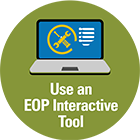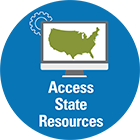Considering the Mental Health Needs of Students and Staff in Your Emergency Operations Plan

Throughout the academic calendar year, education agencies design and provide mental health supports to help ensure that the whole school/campus community can learn and work in a positive environment. This occurs through assessments by school psychologists, therapy from school social workers, employee wellness programs, etc., and can help schools, school districts, and institutions of higher education (IHEs) build their preparedness capacity. Too often the value and importance of this work are first recognized during and in the immediate aftermath of an emergency event. To build on the expertise and success of existing programs, policies, and roles, safety teams can proactively incorporate existing mental health supports into emergency operations plans (EOPs). Whether planning for the provision of mental health supports to individual students or the whole school/campus community following an emergency event, teams should work collaboratively with community partners.
Planning teams may integrate these important supports into the EOP and its Public Health, Medical, and Mental Health Annex using the six-step planning process. For example, as the multidisciplinary planning team is formed during Step 1, consider including school-based mental/behavioral health practitioners (e.g., counselors, school psychologists, school social workers) and representatives from the local health and mental/behavioral health agencies. These practitioners can offer valuable insight into student mental health, especially those individuals who work closely with students; these insights can ultimately help inform the planning team as it incorporates mental health supports into the EOP.
As you observed and participated in Mental Health Awareness Month activities, we hope you gained a better understanding of the role mental health plays in everyday school safety, which includes supporting continuity of operations and helping to reduce disruptions to teaching and learning in the case of a potential emergency event. We encourage you to revisit the role of mental health in higher ed and K-12 school safety, security, emergency management, and preparedness (school safety); reflect on lessons learned from the past year; and update/maintain your EOP, including the Public Health, Medical, and Mental Health Annex. Planning teams can consider how mental health supports will be provided to students and staff before, during, and after an emergency, both in person and in the virtual setting; help ensure that the mental health needs of the whole school community will be met, including individuals with disabilities and other access/functional needs; communicate and work collaboratively with their community partners to ensure that their plans are coordinated; and review, revise, and continually enhance their EOP and Public Health, Medical, and Mental Health Annex.
Review, Revise, Maintain, and Continually Enhance Your EOP
According to the traditional format, which is one possible format for the EOP, the Public Health, Medical, and Mental Health Annex may be found in the Functional Annexes section of your EOP. This is because mental health is a cross-cutting function that always applies to everyday school safety and may be especially relevant following a tragedy, which may result from more than one threat or hazard. The Federal school safety guidance recommends that this annex be included in a high-quality EOP and consider how to build school safety before, during, and after an emergency. As your planning team reviews, revises, and/or creates goals, objectives, and courses of action for the function of public health, medical, and mental health, consider
- Strengthening relationships with and among community partners (e.g., health and mental/behavioral health agencies) that have a shared responsibility in the health and well-being of the community, including the community’s schools and IHEs. Consider scheduling a meeting to share ideas for integrating mental health supports into the classroom and school day, such as training staff on identifying symptoms and students in need of such support. Not only does this reinforce collaboration in the school/campus community’s culture but it can also help to connect students, staff, and families to additional supports in their communities outside of the school day.
- Conducting assessments, such as a culture and climate assessment, or surveys that can provide data to help planning teams better understand the prevalence of behaviors that negatively impact the teaching and learning environment as well as those that help to foster trusting relationships; implement related programming to support the whole school community; and integrate ways to measure how the effectiveness of programs and policies can inform the continual enhancement of the school EOP and the Public Health, Medical, and Mental Health Annex.
- Incorporating a trauma-informed approach in the school EOP that can contribute to creating a safe learning environment for all students. Students have been impacted by a range of hazards and threats during the past year, such as natural hazards or adversarial threats, in addition to the impacts caused by the coronavirus disease 2019 (COVID-19) pandemic, including separation from school and school supports; feelings of isolation; reduced perception of safety; parental loss of income; and even the death of a family member, friend, or member of the school/campus community. All students, therefore, may benefit from more intensive school-based mental health supports, and schools and IHEs can integrate these into their upcoming milestones: conclusion of the 2020-21 academic year, beginning of summer academic enrichment activities, and preparation for the launch of the upcoming 2021-22 academic year.
- Providing opportunities for staff to develop resiliency and practice self-care strategies. These strategies are not only critical for fostering a positive workplace but also for supporting the well-being of the whole school community. Educators need support as they provide support to their students, and resilience strategies can help strengthen staff’s capacity and empower staff to better support the social, emotional, and academic needs of the students in their classrooms. Supporting staff benefits the whole school community and builds capacity for coping with emergency events before, during, and after.
- Ensuring that mental health supports are responsive to and accessible for the whole school community through a variety of delivery methods and through targeted supports. Effective programming must consider the needs of students and staff with access and functional needs, including, but not limited to, individuals with disabilities; English language learners; and students and staff from religiously, racially, and ethnically diverse backgrounds. Schools, school districts, and IHEs may consider providing supports in multiple languages; in different settings, such as in groups or individually; and through different mediums, such as synchronous and asynchronous supports. The planning team may also consider inviting representatives of students and staff from different cultural groups as well as representatives of students and staff with access and functional needs to determine strategies for making mental health supports accessible.
Plan for Mental Health in the Context of Reopening
 As schools across the country return to in-person learning, some students and staff may require more intensive mental health supports as they process their experiences during the past year and transition back to the classroom. In 2020, more children under the age of 18 visited emergency departments for mental health-related visits than in 2019. To help schools address this need, the U.S. Department of Education (ED) released the following helpful resources that discuss student mental health and staff well-being in the context of school reopening:
As schools across the country return to in-person learning, some students and staff may require more intensive mental health supports as they process their experiences during the past year and transition back to the classroom. In 2020, more children under the age of 18 visited emergency departments for mental health-related visits than in 2019. To help schools address this need, the U.S. Department of Education (ED) released the following helpful resources that discuss student mental health and staff well-being in the context of school reopening:
- ED COVID-19 Handbook, Volume 2: Roadmap to Reopening Safely and Meeting All Students’ Needs, ED. Provides strategies for providing equitable educational opportunities and supports for the whole school community, with a focus on creating safe and healthy learning environments, addressing lost instructional time, and supporting educator and staff stability and well-being. This resource specifically highlights the impacts of the pandemic on student and staff mental health and outlines strategies for incorporating mental health supports into the return-to-school process.
- ED COVID-19 Handbook, Volume 1: Strategies for Safely Reopening Elementary and Secondary School, ED. Provides safe practices for in-person learning, including masking practices; physical distancing practices; cohorting/podding and staffing considerations for physical distancing; transportation considerations; encouragement of families and staff to check for symptoms at home; handwashing and respiratory etiquette; safety considerations related to extracurricular activities and athletics programs; and support of ongoing engagement with educators, families, and the school community.
- Safer Schools and Campuses Best Practices Clearinghouse, ED. Offers a collection of best practices and lessons learned from practitioners in the field on safe and healthy environments; supports to young children, students, and families; and early childhood provider, teacher, faculty, and staff well-being, professional development, and supports. Resources addressing mental health are available.
Access Resources on Mental Health Planning Topics
The REMS TA Center Website offers schools, school districts, and IHEs, with their community partners, resources from ED, the REMS TA Center, and Federal partners on the topic of mental health and EOP planning, which includes resiliency, trauma-informed care, psychological first aid (PFA), and annex development.
Training
- Resilience Strategies for Educators: Techniques for Self-Care and Peer Support Trainings by Request, REMS TA Center. Learn about resilience strategies following emergency events and how to engage in and teach others about this critical topic. This training is offered in live and virtual formats and as a downloadable training module.
- Trauma-Informed Care for Schools Before, During, and After Possible Emergency Events Webinar, REMS TA Center. Learn about trauma and retraumatization, manifestations of trauma in students, strategies for implementing a trauma-informed approach, and planning considerations for how schools can integrate trauma in their EOPs.
- Training Package: Leading Trauma-Sensitive Schools, National Center on Safe Supportive Learning Environments. Use these materials to train your colleagues on adopting a trauma-sensitive approach.
- School EOPs In-Depth: Developing a Bereavement and Loss Annex Online Course, REMS TA Center. Learn online about common manifestations among children related to bereavement and loss and how to include plans for responding to and supporting children and youth experiencing bereavement and loss in a comprehensive school EOP.
- Developing a Recovery Annex Training Module, REMS TA Center. Use these materials to train your colleagues on the Recovery Annex and concrete steps for integrating the development of a Recovery Annex into a comprehensive school EOP. This package contains a tabletop exercise.
- Responding to Bereavement and Loss Training Module, REMS TA Center. Use these materials to train your colleagues on the developmental factors in children and adolescents that may impact bereavement and the need to outline protocols and procedures that will be followed prior to, as well as after, an emergency event.
- Planning to Recover From Emergencies at Districts and Schools Webinar, REMS TA Center. Learn online about how K-12 schools and school districts can better plan to recover from emergency events and be ready for a range of threats and hazards.
- Implementing Psychological First Aid (PFA) in School and Postsecondary Settings Webinar, REMS TA Center. Learn online about PFA, its role during and following an emergency, and implementation strategies for its use in both the K-12 and the higher education settings.
- Psychological First Aid: Addressing Mental Health Distress During Disasters Webinar, U.S. Department of Health and Human Services, Centers for Disease Control and Prevention (CDC). Learn online about PFA and online resources and trainings available on the topic. This Webinar was hosted by the CDC’s Emergency Partners Information Connection.
Resources
- Resilience Quick Links for School Personnel, Families, and Students: Ensuring the Well-Being of the Whole School Community During School at Home, REMS TA Center. Access key practical steps and quick links to learning opportunities and resources on resilience and well-being in the context of a pandemic and other emergency events.
- Creating, Supporting, and Sustaining Trauma-Informed Schools: A System Framework, The National Child Traumatic Stress Network (NCTSN). Read about a framework that helps schools, with their community partners, create a trauma-informed school environment, which includes a tiered approach for providing support to students. This framework can be easily integrated with the six-step planning process, as put forth in the jointly issued Guide for Developing High-Quality School Emergency Operations Plans (School Guide).
- Child Trauma Toolkit for Educators, NCTSN. Read about the psychological and behavioral impact of trauma on elementary school, middle school, and high school students as well as strategies for supporting students who have experienced trauma.
- 10 Tips for Teaching the Psychological First Aid Model for K-12 Education Agencies, REMS TA Center. Read about the PFA model, its core elements, and 10 tips to support its implementation before, during, and after emergency events.
- Supporting Efforts to Create a Public Health, Medical, and Mental Health Annex as a Part of Your Emergency Operations Plan, REMS TA Center. Access resources from the REMS TA Center, ED, and Federal agency partners on the topic of public health, medical, and mental health within K-12 schools and IHEs.
- Recovery for Schools and School Districts, REMS TA Center. Read this fact sheet for information on the timeframes and four components of recovery, examples of recovery activities, and how to integrate recovery efforts into emergency planning.
|












 As schools across the country return to in-person learning, some students and staff may require more intensive mental health supports as they process their experiences during the past year and transition back to the classroom. In 2020, more children under the age of 18 visited emergency departments for
As schools across the country return to in-person learning, some students and staff may require more intensive mental health supports as they process their experiences during the past year and transition back to the classroom. In 2020, more children under the age of 18 visited emergency departments for